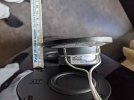Hi everyone,
I am thinking of swapping my tweeters of my large speakers. It's actually pretty easy and I found a suitable model.
The current tweeter is this one in a slightly changed casing: https://doc.soundimports.nl/pdf/brands/Scan-Speak/D2608-913000/pdf_SB Acoustics_D2608-913000_1.pdf
The new tweeter shall be: https://doc.soundimports.nl/pdf/brands/SB Acoustics/TW29BN-B/pdf_SB Acoustics_TW29BN-B_1.pdf
It's kind of a "what if" project to see if this beryllium tweeter with its extended upper range can really provide the so often claimed "holographic transparency".
Since the data is pretty close but not really I wanted to ask you for things to watch out for.
1. How much do I have to worry about phase?
2. The new tweeter has higher sensitity - do I need to put in a power resistor into the path?
What else is there?
Thank you for your time reading this!
I am thinking of swapping my tweeters of my large speakers. It's actually pretty easy and I found a suitable model.
The current tweeter is this one in a slightly changed casing: https://doc.soundimports.nl/pdf/brands/Scan-Speak/D2608-913000/pdf_SB Acoustics_D2608-913000_1.pdf
The new tweeter shall be: https://doc.soundimports.nl/pdf/brands/SB Acoustics/TW29BN-B/pdf_SB Acoustics_TW29BN-B_1.pdf
It's kind of a "what if" project to see if this beryllium tweeter with its extended upper range can really provide the so often claimed "holographic transparency".
Since the data is pretty close but not really I wanted to ask you for things to watch out for.
1. How much do I have to worry about phase?
2. The new tweeter has higher sensitity - do I need to put in a power resistor into the path?
What else is there?
Thank you for your time reading this!

